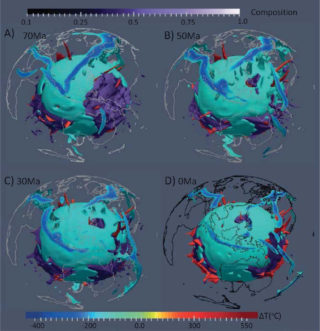The formation of mantle “lone plumes”
It has been widely accepted that the vast majority of the Mesozoic-Cenozoic mantle plumes formed above the two large low shear velocity provinces (LLSVPs) in the lower mantle. However, there are obvious exceptions. One possible case is the Yellowstone plume which is at present outside the Pacific LLSVP. Another is the Hainan plume in the South China Sea region that is located within the broad global mantle downwelling zone. Li et al. (2014) therefore classified such plumes as “lone plumes”. Here, we use the Hainan plume example to investigate the feasibility of such lone plumes being generated by subducting slabs in the mantle downwelling zone using 3D geodynamic modelling. Our geodynamic model has a high-resolution regional domain embedded in a relatively low resolution global domain, which is set up in an adaptive-mesh-refined, 3D mantle convection code ASPECT. We use a recently published plate motion model to define the top mechanical boundary condition. Our modelling results show that the Western Pacific subduction systems started to promote the formation of a lower-mantle thermal-chemical pile in the vicinity of the future South China Sea region since 70 Ma ago. As the top of this lower-mantle thermal-chemical pile rises, it first moved to the west, and finally rested beneath the South China Sea. The presence of a thermal-chemical layer (possible the D″ layer) in the model helps stabilizing the plume root.

Relevant publication:
Zhang, N., Li, Z.X.. Formation of mantle “lone plumes” in the global downwelling zone — A multiscale modelling of subduction-controlled plume generation beneath the South China Sea. Tectonophysics 723, 1-13 (2018).
